RGB, the colors of the century It is a sample of digitized works, contained in data sent over the Internet and prepared on site with digital printers, an application for digital tablets and elements assembled by the staff of the receiving institution. This exhibition was designed and curated by Maestro Cruz-Diez in 2010. That same year it was sent for the first time to China, becoming a successful traveling exhibition in important museums and universities in that country.
Cruz-Diez uses the term RGB, referring to a system based on the sum of primary light colors. In Spanish, the English acronym RGB (Red, Green and Blue) is usually used. This chromatic model is known as additive synthesis, since when the colors are added they create a new one. Color is achieved using light. Many are unaware that their monitors, LCD screens, tablets, mobile phones and other digital media use this model to display colors; Any color seen on a screen is made up of varying percentages of each. For example, if all three colors are illuminated, you get white, while if none of them are illuminated, you get black. When the three colors are combined with each other, they produce the secondary colors yellow, cyan, and magenta.
When Cruz-Diez conceived this exhibition in 2010, he wrote: “Before color television appeared, all the images we saw in print were obtained thanks to the colors yellow, blue, red and black. They are chemical colors for an opaque support such as paper. Television and all numerical devices generate luminous images, therefore, the colors are physical, the colors of the prism. In these works, of systematic and programmed conception, I have only used the colors red, green, blue and black, plus the white of the opaque support. The result is apparently contradictory, since not being a luminous support, I obtain the colors of the prism, the colors of light. It is an investigative discourse that I have been developing since 1959 until today, and each time I am surprised by the unforeseen results that arise. That joy of discovery and wonder is what I try to communicate to the viewer in each of my works.”
RGB, the colors of the century, includes two-dimensional works from the Additive Color series, based on the juxtaposition of two or more colors that produce new chromatic ranges depending on the luminosity and distance from the viewer. For their part, those titled Chromatic Induction are related to the post-image phenomenon, where the eye is induced to perceive the complementary colors of those found in the plane. The virtual colors are as real as the pigments used in the support. The works called Color in Space complement the exhibition.
The room has an interactive program for digital tablet created by the artist and his son Carlos in 1995, through which attendees can interpret their works. As the artist expressed it: “The Interactive Random Chromatic Experience is an application for computers and tablets, which allows the user to enter the expressive world of my work, as a performer would do before a score. For this reason, when the work is printed it says “Cruz-Diez, interpreted by…”.
Pedestrian crossings and roads in San José
Among the innovative ideas of Carlos Cruz-Diez In contemporary art one finds its “ephemeral interventions” in urban space. Since 1975, its pedestrian crossings and walkways have been presented in various capitals around the world. In these works, Cruz-Diez uses Chromatic Inductions and Additive Colors. Regarding his pedestrian crossings, the artist stated: “Given that art is a complex communication mechanism, I think that the street is an ideal support to make my speech reach a greater number of people. With the chromatic intervention of the pedestrian crossings in the streets, I intend to change the routine of the passers-by in their daily journey, since they arouse surprise by modifying the immutable codes that we use when crossing the road. The most important thing is that I get the city dweller to interact with my works as he passes by, becoming a co-author of them, since he is the one who makes new ranges of colors emerge while he moves. Unlike painting that stops time, my works produce events in the space and time of the journey. It is a reflection on the instability and ambiguity of color and that produces amazement. The artist has to propose unprecedented situations and provoke surprises, awaken dormant perceptions in those who observe them, stimulating his imagination to other readings of reality.
The pedestrian crossing is located in front of the Buenaventura Corrales school, known as the Metallic Building. The second intervention is a walkway in the plaza of the Museum of Costa Rican Art. These interventions have the original designs, plans and supervision of the Atelier Cruz-Diez Paris, directed by Carlos Cruz-Diez Jr.; the logistical support of the Logistic Fine Arts Miami team, in charge of printing the works, as well as the participation of volunteers from EPA and the Municipality of San José.
“The arrival of RGB: The Colors of the Century to our museum is a very significant event for the Costa Rican scene, it is an opportunity to bring the population closer to the works of one of the most influential artists of the 20th century and inspire new generations. so that they can explore the infinite possibilities of color, along with a series of educational activities that we have prepared for those who visit us,” said Esteban Calvo, director of the Museum of Costa Rican Art, located in the Sabana Metropolitan Park, in San José, its schedule It is from Tuesday to Sunday, from 9:00 am to 4:00 pm Admission is free.
NULL


